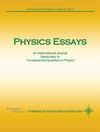关于各向异性量子引力的说明
IF 0.5
Q4 PHYSICS, MULTIDISCIPLINARY
引用次数: 0
摘要
在牛顿理论中,所有质量的引力都是各向同性(球形)的。在本文中,我们将考虑非球面-各向异性-引力过程,从而得出暗物质的独特观点:暗物质是引力子凝聚物。我们还将讨论暗能量和最终第五种相互作用的可能性。本文章由计算机程序翻译,如有差异,请以英文原文为准。
A note on anisotropic quantum gravity
In Newton’s theory, all mass gravitates in an isotropic (spherical) manner. In this paper, we will consider aspherical—anisotropic—gravitating processes, which lead to a unique view of dark matter: dark matter is a graviton condensate. We also discuss
dark energy and the possibility of a final, fifth interaction.
求助全文
通过发布文献求助,成功后即可免费获取论文全文。
去求助
来源期刊

Physics Essays
PHYSICS, MULTIDISCIPLINARY-
自引率
83.30%
发文量
50
审稿时长
6-12 weeks
期刊介绍:
Physics Essays has been established as an international journal dedicated to theoretical and experimental aspects of fundamental problems in Physics and, generally, to the advancement of basic knowledge of Physics. The Journal’s mandate is to publish rigorous and methodological examinations of past, current, and advanced concepts, methods and results in physics research. Physics Essays dedicates itself to the publication of stimulating exploratory, and original papers in a variety of physics disciplines, such as spectroscopy, quantum mechanics, particle physics, electromagnetic theory, astrophysics, space physics, mathematical methods in physics, plasma physics, philosophical aspects of physics, chemical physics, and relativity.
 求助内容:
求助内容: 应助结果提醒方式:
应助结果提醒方式:


